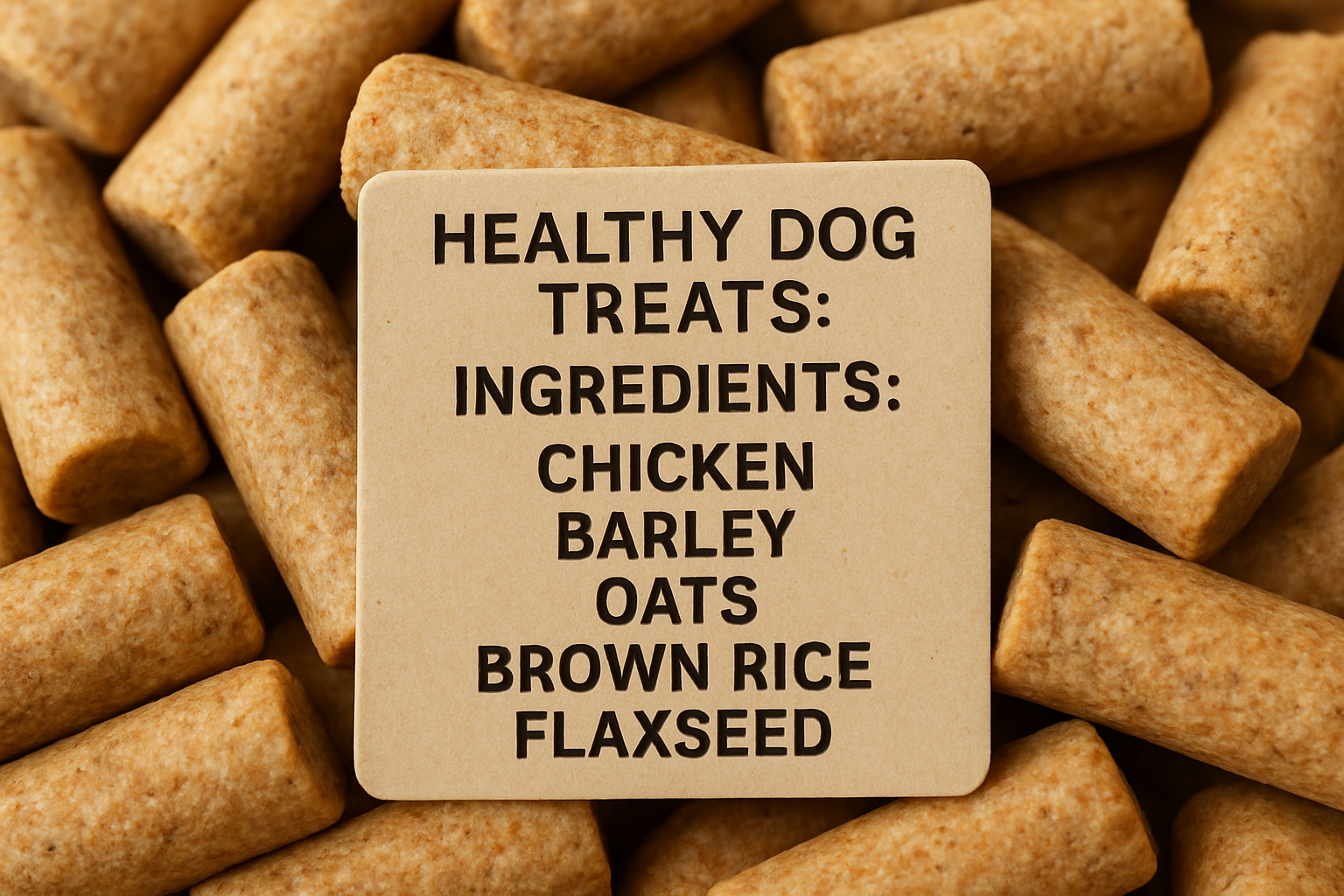Dog treats are a beloved part of any pup’s day.
But what are they, exactly?
This ultimate guide will give you the complete breakdown on dog treats.
Some are crunchy biscuits, packed with flavor and nutrients.
Some are soft morsels perfect for training puppies or senior dogs.
Some are long-lasting chews that keep dogs busy and improve dental health.
Some are wholesome homemade recipes you can easily make yourself.
Some dog treats are designed for special needs like allergies, weight management, or joint support.
Let’s dive right in.
Table of Contents
- What Are Dog Treats?
- Types of Dog Treats and Their Benefits
- DIY Homemade Dog Treat Recipes
- How to Choose Healthy Dog Treats
- The Role of Dental Dog Treats
- Specialized Dog Treats: Joint, Weight, Allergy
- Budget-Friendly Dog Treat Options
- Frequently Asked Questions
- What’s Your Next Step?
What Are Dog Treats?
Dog treats are specially formulated or homemade snacks given to dogs as rewards, supplements, or occasional indulgences. Unlike their balanced meals, treats are meant to be given in moderation. They are an essential training tool and a method to build strong bonds between you and your dog.
From crunchy biscuits to soft chews to rawhide sticks, dog treats vary widely in composition, texture, and purpose. Their nutritional value depends largely on ingredients, processing methods, and portion size. It's important to choose treats that support your dog's overall health without overloading calories or harmful additives.
Types of Dog Treats and Their Benefits
Understanding the variety of dog treats can help you pick the right one to reward your furry friend. Below is a detailed overview of common types:
Crunchy Biscuits and Cookies
These classic dog treats are dry, crunchy, and often baked or dehydrated. They provide satisfying texture and are great for regular rewarding, especially during training. Dog cookies can include wholesome ingredients such as oats, peanut butter, sweet potatoes, and real meat flavors.
Example: Old Mother Hubbard’s variety packs offer flavors like peanut butter and apples or bacon and cheddar cheese that many pups adore (NBC Select).
Soft Treats
Soft, moist treats are ideal for puppies who are teething or senior dogs who may have difficulty chewing harder snacks. They are flavorful and easy to break into smaller pieces, making them perfect for training sessions where multiple rewards are needed.
Soft treats often contain added vitamins and minerals and can incorporate flavors like bacon, chicken, or liver. Their tenderness appeals to picky eaters and dogs requiring sensitive diets.
Jerky and Meat-Based Treats
Jerky treats are protein-rich and highly palatable, made typically from beef, chicken, or other meats. They often contain minimal ingredients, making them suitable for dogs with allergies or food sensitivities.
Look for jerky designed specifically for dogs to avoid spices or harmful additives. Brands like DOGDELI specialize in premium all-natural jerky treats made from U.S.-sourced ingredients (Dogdeli).
Dental Treats
Dental treats are formulated to help reduce plaque and tartar buildup while freshening breath. Some come with certification from the Veterinary Oral Health Council (VOHC) for their efficacy.
They work mainly due to their rough or chewy texture. However, ingredient quality matters—many so-called dental treats may contain fillers and high carbohydrates, which can counter dental health benefits.
Natural chews like bully sticks, raw bones, or coconut husk chews can often provide better oral benefits when fed under supervision (YouTube Vet's Guide to Dental Treats).
Long-Lasting Chews
Chews including bully sticks, raw bones, and collagen sticks keep dogs engaged and help exercise jaws. Many are digestible and provide nutritional benefits like lean proteins and vitamins.
Always choose appropriately sized chews to avoid choking hazards and supervise your dog while chewing. Bully sticks are especially favored due to their digestibility and minimal splinter risk (AKC).
Freeze-Dried and Dehydrated Treats
Freeze-dried treats maintain nutrients and last long shelf lives. They are often single-ingredient, making them easy on sensitive stomachs. These treats are perfect for special occasions or occasional rewarding.
Freeze-dried liver or salmon treats are some favorites for picky or sensitive dogs (NBC Select).
Specialty Treats
There are treats that specifically focus on joint health, calming effects, or allergy-friendly diets. These often include added supplements like glucosamine for joints or ingredients such as pumpkin for digestion.
Thinking about your dog’s specific needs? It’s more than just flavor — it’s health.
DIY Homemade Dog Treat Recipes
Making dog treats at home is a fantastic way to ensure quality, control ingredients, and save money. Many recipes require just a few simple ingredients you likely already have.
Here are some easy and popular homemade dog treat ideas:
3-Ingredient Peanut Butter and Sweet Potato Treats
This recipe includes mashed sweet potato, all-natural peanut butter (without additives or sweeteners), and oat flour. The fruit and protein combo offers fiber and healthy fats.
Simply mix the mashed sweet potato with peanut butter, stir in oat flour, roll out the dough, and cut into shapes. Bake at 400°F for 12–15 minutes depending on desired softness. These treats are budget-friendly and loved by dogs for their natural taste (It Doesn't Taste Like Chicken).
Ground Beef Training Treats
Use lean ground beef, oat flour, and eggs. Combine into a dough, roll thin, cut into bite-sized squares, and bake. After initial baking, a long drying process at a lower temperature creates shelf-stable crunchy treats.
These cost a fraction compared to store-bought treats and have wholesome, recognizable ingredients (Stop Wasting $$$ on Dog Treats - Make These Instead [YouTube]).
Why Make Your Own?
- Control on added sugars, salt, and preservatives.
- Customize recipes for allergies or preferences.
- Cost-effective at producing hundreds of treats.
- Surprise and delight your dog with fresh, wholesome snacks.

How to Choose Healthy Dog Treats
Not all dog treats are created equal. Here’s what to look for to make smart, dog-friendly choices:
Check the Ingredients
Avoid treats with artificial colors, flavors, excessive salt, and sugars (like syrups or molasses). Watch out for harmful sweeteners such as xylitol, which is poisonous to dogs.
The best treats contain recognizable, limited ingredients — real meat, wholesome vegetables, and natural grains like oats or rice (AKC).
Understand Calorie Content
Treats should comprise no more than 10% of your dog’s daily caloric intake to prevent obesity or nutrient imbalances. Look at packaging for calories per treat and adjust portions accordingly. Low-calorie options are great for weight management (NBC Select).
Consider Special Needs
Puppies and senior dogs benefit from softer treats. Dogs with allergies may need grain-free or single-ingredient options. Joint health treats often include glucosamine and chondroitin.
Size Matters
Pick treat sizes proportional to your dog’s breed and training purpose. Training treats should be small and easy to chew; enrichment treats can be larger and longer-lasting (AKC).
Beware of Fillers and Low-Quality Products
Cheap treats may use wheat gluten, glycerin, or high-carb fillers that may cause digestive issues and poor metabolic health. Choose brands committed to transparency and quality sourced ingredients (Dogdeli).
Trust Certifications and Labels
Look for marks like the Veterinary Oral Health Council (VOHC) approval for dental treats and AAFCO nutritional statements, keeping in mind treats are snacks, not complete meals.
Bonus Tip: Rotate between treat types to provide varied nutrients and keep your dog engaged without overloading any one ingredient.

The Role of Dental Dog Treats
Dental health is a crucial but sometimes overlooked aspect of canine wellness. Many dog treats are marketed as dental solutions.
How effective are dental dog treats?
Dental treats work primarily through their texture to scrape plaque and tartar from teeth. Some also contribute antioxidants and vitamins supporting gum health.
However, some popular dental treats contain high carbohydrate levels and fillers that may promote plaque formation or cause metabolic issues if overused. So ingredient quality matters greatly (Vet's Guide to Dental Treats).
Natural chews like bully sticks, raw bones, and yak chews provide abrasive action to mechanically clean teeth while delivering good nutrition. These tend to have fewer additives and carbs.
Regular brushing alongside dental treats is the best approach to maintain oral health. Incorporating treats that both engage your dog and contribute to dental hygiene can help—but never replace dental care routines with treats alone.
Consider size and chewing style: Small dogs may need softer dental treats to avoid choking, while vigorous chewers may benefit from tougher chews for longer-lasting cleaning effects.
Specialized Dog Treats: Joint, Weight, Allergy
Dogs with health challenges require treats tailored to their needs.
Joint and Mobility Treats
Treats containing glucosamine, chondroitin, and omega fatty acids support cartilage health and joint function, especially beneficial for aging or arthritic dogs.
They are often soft or semi-soft for easy consumption and disguised as tasty rewards. These treats are a sneaky way to supplement your dog’s joint regimen with deliciousness (NBC Select).
Weight Management Treats
Low-calorie, high-fiber treats help keep your dog satisfied without contributing excess calories. Treats with pumpkin, green beans, or bell peppers are good natural options offering vitamins too.
Consult with your vet before changing your dog’s treat routine for weight control purposes.
Allergy-Friendly Treats
Some dogs have digestive or skin sensitivities requiring grain-free, single-protein or novel-ingredient treats. Freeze-dried liver or venison treats can be gentle options for these pups.
Always read labels and check for common allergens. Ingredients should be simple and recognizable to avoid reactions.
Expert insight: Veterinarians recommend gradually introducing new treats and monitoring for digestive or allergic reactions to ensure safety.
Budget-Friendly Dog Treat Options
Feeding your dog high-quality treats doesn’t have to drain your wallet. Several strategies can keep costs down without compromising quality.
Make Your Own Treats
As demonstrated earlier, simple homemade recipes using lean meats, oats, sweet potatoes, and natural nut butters can produce hundreds of treats for less than store-bought prices.
Buy in Bulk or Choose Multipacks
Many premium treat brands offer value packs or subscription discounts. This is often cheaper per treat and prevents running out unexpectedly.
Choose Single-Ingredient Treats
Treats like bully sticks or freeze-dried liver are often more affordable and nutrient-dense than complex processed options.
Train with Tiny Treats
Using smaller treat pieces for training means you are giving less per reward, stretching your supply further without skimping on positive reinforcement.
Rotate Store-Bought and Homemade
Alternating commercial treats with homemade ones gives variety and cost control.
Want more ideas on selecting quality dog foods and treats? Check out The Ultimate Guide to Dog Food: Nutrition, Selection, and Top Choices to complement your treat knowledge.

Frequently Asked Questions about Dog Treats
How many treats can I safely give my dog?
Generally, treats should make up no more than 10% of your dog’s daily caloric intake to avoid weight gain and nutrient imbalances. This varies by dog size, age, and activity. Always monitor your dog’s weight and adjust serving sizes accordingly.
Are homemade dog treats better than store-bought?
Homemade treats give you full control on ingredients and cost, but commercial treats can offer convenience, specialized nutrition, and safety certifications. A mix of both often works best to balance quality and practicality (It Doesn't Taste Like Chicken).
Can dog treats help with dental health?
Yes, many dental treats mechanically reduce plaque and tartar. However, nothing should replace regular tooth brushing. Natural chews combined with dental treats and brushing create the best overall dental care routine.
What should I avoid in dog treats?
Avoid artificial sweeteners (especially xylitol), preservatives, excessive salt, fillers like wheat gluten or glycerin, and toxic ingredients such as grapes, raisins, onions, or chocolate. Always check ingredient lists carefully.
Are grain-free treats healthier for dogs?
Not necessarily. Grain-free is beneficial only for dogs with diagnosed grain allergies. Some grain-free formulas may lack necessary nutrients and have been linked to heart issues. Always consult a vet before switching (AKC).
What’s Your Next Step?
Tell us in the comments: How will you apply this to your dog treats selection? For personalized advice, contact us!
from Talis Us - Blog https://ift.tt/RHbtjQ3








0 comments:
Post a Comment